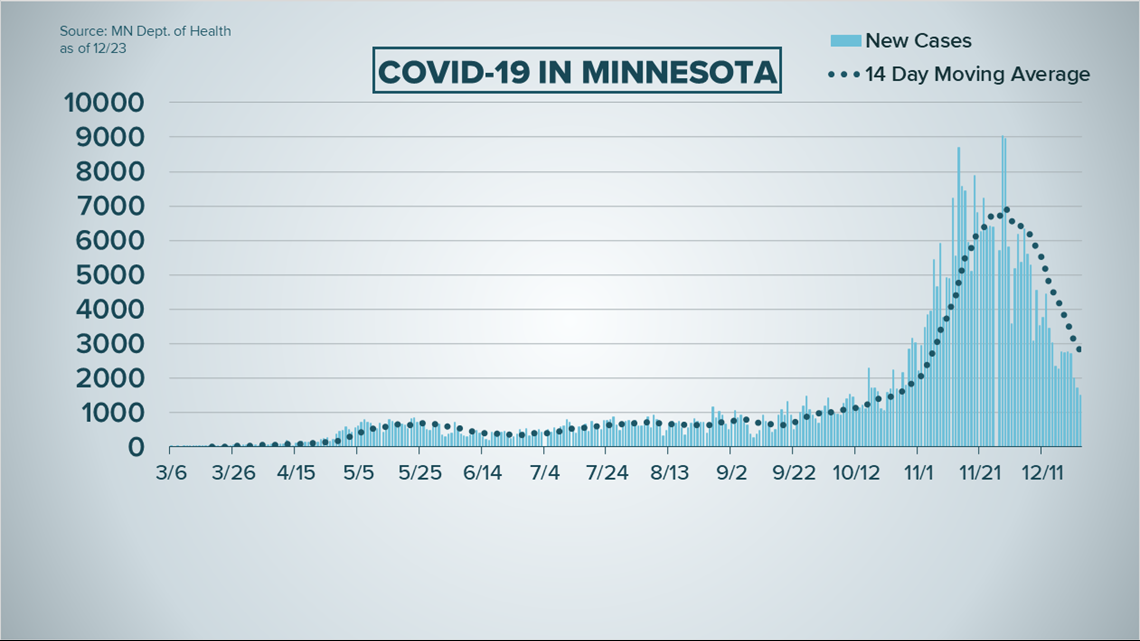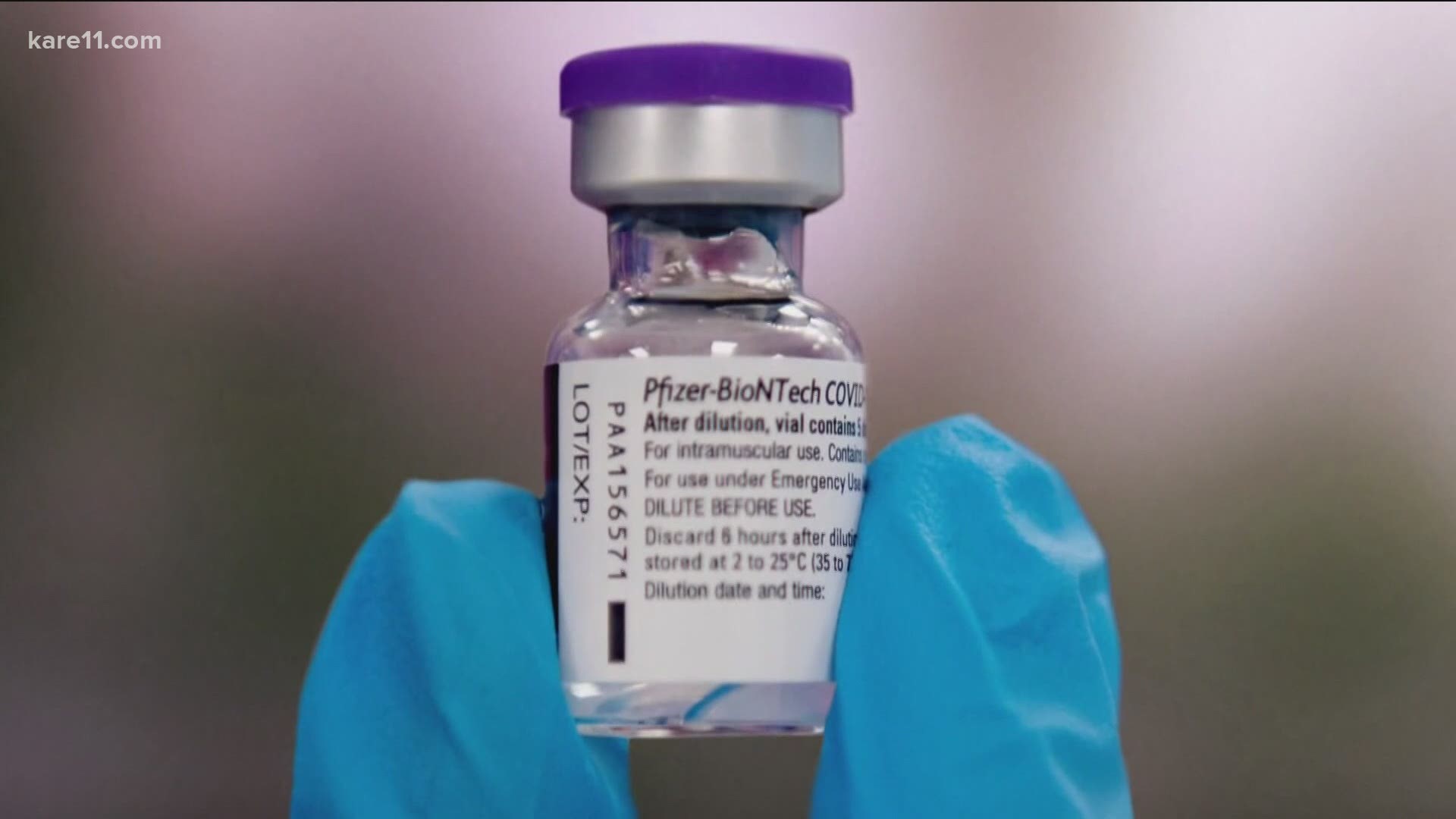Wednesday, Dec. 23
- MDH says delays on Moderna vaccine shipments will impact at least four Minnesota providers, weather adds further complications
- Gov. Tim Walz signs executive order to open pools for limited use
- White House coronavirus coordinator Deborah Birx says she will retire
- U.S. reaches deal with Pfizer for 100 million more vaccine doses
- Coronavirus mutation probably in U.S., experts say, but not likely to impact vaccine
2 p.m.
State health officials said Wednesday that some delays on Moderna vaccine shipments nationally will impact Minnesota, and a winter storm could exacerbate the situation.
Minnesota Department of Health (MDH) Infectious Disease Director Kris Ehresmann said on a media briefing call Wednesday that when MDH became aware of the shipping delays, they began reaching out to providers.
They found that four providers in Minnesota have been informed that their vaccine shipments will be delayed, and weather will complicate that as well. MDH will provide updates to the public as they become available.
Ehresmann also announced Wednesday that MDH now has a publicly accessible page giving information on vaccines coming to Minnesota at mn.gov/covid19.
Ehresmann pointed out that there is lag time between when the vaccine doses are allocated to Minnesota, delivered, administered and then reported. She said while the website shows 2,999 doses administered today, MDH has preliminary data that more than 11,500 doses have already been administered in Minnesota.
MDH Commissioner Jan Malcolm said on the call that COVID-19 spread continues at an “unabated pace” nationally and globally. In Minnesota, however, case numbers continue dropping from their November peak, with the lowest daily count since Oct. 21 reported on Wednesday.
"Happy to say that the data continues to show some encouraging trends," Malcolm said, though deaths continue at a "heartbreaking pace."
Malcolm said Minnesota will likely cross the threshold of 5,000 deaths from the virus on Christmas Eve.
"What a sad time of year to think about 5,000 families not having their loved ones with them," she said.
Malcolm said it's important to remember that although Minnesota's case numbers are going down relative to the state's peak, the numbers are still high when compared with many other places in the country.
MDH Infectious Disease Director Kris Ehresmann said that since hospitalization and death numbers are lagging significantly from case numbers, the high rates of death Minnesota is seeing in December are a result of the peak case numbers back in November.
"As we were looking at the highest case numbers in November, we were seeing our deaths increase, but we weren't seeing the highest deaths in November," she said. "We've had a December with the highest death counts. And that's because in December we are sort of reaping the results of the high November rates."
Ehresmann said she hopes that January death numbers will decrease as a result of declining cases in December.
Malcolm said that Minnesotans' hard work to take prevention guidelines seriously is having a positive impact on the COVID-19 situation statewide.
"For that we thank you, and your neighbors thank you," she said. "This is important not just to protect yourself and your immediate family."
Malcolm asked Minnesotans to limit indoor social gatherings to two households with no more than 10 people, and maintain social distance. Outdoor gatherings are limited to 15 people with no more than three households.
"Now is not the time to let down our guard, and these numbers have fallen because of what we've done," Malcolm said. "It's important to keep paying attention."
11 a.m.
New COVID-19 cases in Minnesota continue to drop, but deaths again spiked on Wednesday.
According to the Minnesota Department of Health, 75 people died of the coronavirus in the past day. That's more than three times the daily totals on Monday and Tuesday, but numbers of deaths have frequently been in the 70s and higher over recent weeks, even with cases dropping.
On Wednesday, MDH reported 1,513 new cases of the coronavirus. Of those, 1,207 were identified by PCR test - considered confirmed, and 306 by antigen test - considered probable. That's the lowest number of new cases in over two months, since 1,068 new confirmed PCR cases were reported on Oct. 21.
Testing numbers were down considerably over the past 24-hour reporting period as well, with 17,952 PCR tests and 5,611 antigen tests performed across the state. That's the lowest testing volume since Dec. 15.


Statewide hospitalizations due to COVID-19 have generally been trending downward for the month of December, but they were up as of Tuesday, the latest data available. In the metro, 6.3% of staffed ICU beds are available, and only 3.2% of non-ICU beds are available.
Gov. Tim Walz signed an executive order Wednesday reopening pools for lap swim and organized swim team sports beginning Monday, Jan. 4, 2021. Walz's order specifies that facilities must follow social distancing requirements that are specific to pools and can be found in the Stay Safe Minnesota guidance.
MDH is expected to hold a briefing call at 2 p.m. Wednesday to update the public on COVID-19 spread in Minnesota and recommendations for holiday safety.
Tuesday, Dec. 22
2 p.m.
Governor Tim Walz and Minnesota heath officials held a live media call to discuss vaccine distribution and new cases.
"This is going to take time... but we'll get there," Walz said of the state's effort to distribute COVID-19 vaccines.
The Minnesota Department of Health says it's expecting 94,800 doses of the Moderna vaccine that will primarily be reserved for long-term care residents and staff - this after getting nearly 47,000 doses of the Pfizer vaccine last week.
Health officials expect all of the state's first top-tier recipients will get both doses of a vaccine by the end of January.
"It's not quite as optimistic as we had thought initially, but I think we're in a pretty good place considering we're talking about just three weeks of vaccine availability," said Kris Ehresmann, the Minnesota Department of Health infectious disease director.
Gov. Walz said the situation in the state is showing signs of improvement, but that Minnesotans can't let their guards down for the holiday season. He pointed out Minnesota's new benchmark: 400,000 cumulative cases of COVID-19.
"We’re disheartened to report that we have passed yet another grim milestone of 400,000 cases today," said Health Commissioner Jan Malcolm in a news release. "We reached that number, unfortunately, about as quickly as we expected we would when we hit 300,000 and saw cases climb rapidly in November. We fully intend to do what we can to make sure the next milestone is slower in arriving, if at all."
Malcolm also spoke on the call and said despite the recent downward trend, MDH saw an uptick in hospital beds in use due to COVID-19 in the numbers reported Tuesday.
Malcolm said the state's latest test positivity rate is 8.4% - almost a 2% drop from one week ago. Like the governor, however, she added that Minnesotans can't let their guards down yet.
"As tempting as it is to say, oh good, the numbers are going in the right direction, that's because we're doing the right things and we really need to stay the course," said Malcolm.
Meanwhile, Wisconsin's Department of Health Services (WDHS) reported 120 deaths Tuesday, the most single-day deaths since the pandemic began. The total number of deaths in Wisconsin rose to 4,545, which is approximately 1% of those testing positive for the virus.
Health officials reported 2,403 new cases Tuesday, bringing the total number of cases statewide to 461,015.
On Tuesday, Dec. 22 Gov. Evers announced that his administration has struck a deal with Vault Medical Services to provide free at-home COVID-19 saliva tests, according to the Associated Press. Anyone interested in a test can order one through the state Department of Health Services website starting immediately. Users must collect a sample as a Vault testing supervisor looks on via Zoom and then mail it back to a Vault lab using a prepaid label that comes with the kit. Results will take 48 hours to 72 hours.
Wisconsin health officials say a total of 20,355 people have been hospitalized from the coronavirus since the start of the pandemic, about 4.4% of the total number of people who have been diagnosed with the virus.
Of the confirmed cases in Wisconsin, 19% involve people between the ages of 20 to 29, 16% are between 30 and 39, 15% are between 50 and 59, and 14% are 40 to 49. An estimated 11% are between 10 and 19, and another 11% are between 60 and 69.
As of Tuesday, Milwaukee County reported the largest number of confirmed cases with 81,526, along with 942 deaths. Waukesha County has reported 32,697 confirmed cases and 310 deaths, Dane County has reported 31,867 confirmed cases and 163 deaths, and Brown County has reported 25,317 cases and 160 deaths.
11 a.m.
New cases of COVID-19 continue a downward trend, according to numbers released Tuesday by the Minnesota Department of Health (MDH).
An additional 1,714 coronavirus cases were recorded in the past day, based on results from a relatively low testing volume of 32,195 tests (30,051 PCR, 2,144 antigen). State health officials consider a positive PCR test a confirmed COVID case, while a positive antigen test is considered a probable case.
The new COVID cases bring Minnesota to a new benchmark, breaking the 400,000 milestone with 401,011 cases reported since the start of the pandemic. That number includes 12,338 antigen tests.
MDH says 24 more Minnesotans have died of the virus, bringing fatalities to 4,896. Of that number 3,176, or 65% of them are linked to long-term care or assisted living settings.
Currently 1,060 hospital beds across the state are being used to treat COVID patients, with 228 of those beds in ICU. In the Twin Cities metro, hospital capacity remains tight with 5% of non-ICU beds available, and 7.4% of ICU beds available for use. Total hospitalizations have risen to 20,816 since the onset of COVID-19, with 4,449 of those patients needing care in the ICU.
Young adults make up the largest grouping of Minnesota's coronavirus cases, with people between the ages of 20 and 24 accounting for 41,088 cases and three deaths, followed by those 25 to 29 with 35,974 and six deaths.
The largest group of deaths involves people from 85 to 89, with 929 deaths in 5,291 confirmed cases.
Hennepin County has recorded the most COVID activity with 83,520 cases and 1,321 deaths, followed by Ramsey County with 35,897 cases and 636 deaths, Dakota County with 29,019 cases and 256 deaths, and Anoka County with 28,113 cases and 295 fatalities.
Cook County has the least COVID activity with 101 cases and no deaths.
KARE 11’s coverage of the coronavirus is rooted in Facts, not Fear. Visit kare11.com/coronavirus for comprehensive coverage. Have a question? Text it to us at 763-797-7215. And get the latest coronavirus updates sent right to your inbox every morning. Subscribe to the KARE 11 Sunrise newsletter here. Help local families in need: www.kare11.com/give11.
The state of Minnesota has set up a data portal online at mn.gov/covid19.

